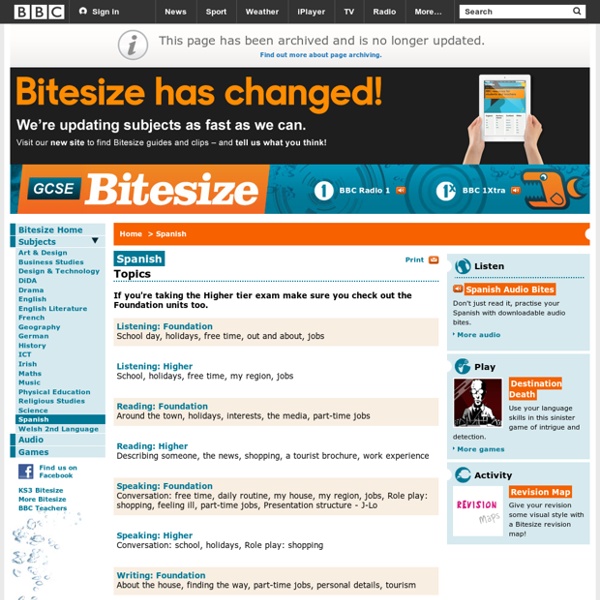



Cambridge IGCSE Spanish - Foreign Language (0530) This syllabus is designed for learners who are learning Spanish as a foreign language. The aim is to develop an ability to use the language effectively for practical communication. The course is based on the linked language skills of listening, reading, speaking and writing, and these are built on as learners progress through their studies. The syllabus also aims to offer insights into the culture and civilisation of countries where the language is spoken, thus encouraging positive attitudes towards language learning and towards speakers of foreign languages. Notice for UK schools: Only the 2015 syllabus is approved by Ofqual and funded in state schools. You can download one or more question papers for a previous session. Syllabuses The syllabus year refers to the year in which the examination will be taken.
GCSE Bitesize - Geography Learn Spanish with free online lessons Spanish Vocabulary Notes and Lists - Vocabulario Español by Woodward Spanish This page is divided into two sections. The first section contains Spanish vocabulary explained in English. The second section contains Spanish vocabulary explained in Spanish. Spanish Vocabulary Topics (in ENGLISH) Over the next months we will create more Spanish Vocabulary pages with English explanations, thinking of the people who have a basic level of Spanish. Pages in English for learning Spanish Vocabulary: Colors - Colors in Spanish, word order and typical things associated with each one Days & Months - The days of the week and the months of the year in Spanish Family Members - Members of the family from your immediate family to relatives. Common mistakes in Spanish (for English speakers) Spanish Vocabulary Topics (en ESPAÑOL) Note that these pages are entirely in Spanish so you can learn the main word and other ones associated with it in its description / explanation. Ciencias Naturales - Natural Science in Spanish Spanish Reading Topics Spanish Reading Passages Spanish Verb Lists
Spanish Verb Mastery - Free Spanish Verb Charts Course: Cambridge IGCSE foreign languages: Speaking test video The aim of this video is to support teacher-examiners in conducting the Cambridge IGCSE foreign language speaking tests. It covers the structure of the test (which includes the different parts and timings of the test), what you will need with you in the examination room, and how to set up the rooms and the exam. Let’s start by looking briefly at the structure of the speaking test Preparation time: Each candidate is given 10 minutes to prepare for the test in a different room from the examination room. The test: To start the test, there is a short 30 second warm-up in the target language. After this short discussion, the role play can start. The next part of the test is topic conversation 1. The final part of the test is topic conversation 2. Let’s now look at what you as the teacher/examiner should do before starting the speaking tests. You must: Before the test you will need to think about what you need in the examination room. Preparation time This lasts 10 minutes. Role play (2 minutes)
Learn Spanish lesson tutorials online free for kids and adults with audio, 100+ topics Introduction to the Spanish topic You start the tutorial with an activity that introduces the Spanish words or sentences you will be learning . You will see a set of pictures one at a time, and for each picture you will see the written word and hear the Spanish audio for that picture. You can repeat the audio for the picture by clicking on the brown telephone sign beside the picture. Move between the topic pictures using the arrow signs. Yes or No? In this activity, you will be shown the pictures one at a time. If you are right, you get a gold star. Either / Or activity to learn in Spanish This activity moves on from the 'Yes / No' lesson activity and offers you two possible answers to each question. You choose an answer by clicking on the written words for that answer. What is it? The final learning activity in our Spanish tutorial shows you many possible answers for each question and you must choose the correct one. When you complete the 'What is it?'
Test your Spanish free online, 100+ topics to choose On the settings screen, select the test you would like to take.A new screen will open with information concerning the test.When you are ready to begin, click 'Start the test'. See below for detailed instructions on using the two tests: Multiple choice test This is a multiple choice activity similar to 'What is it' in the Spanish tutorials. You are shown a randomly selected picture from your chosen topic. The vocabulary for your topic is displayed as a list of Spanish vocabulary items numbered from one to ten. For each picture, you must click on the word/s that match that picture. The test is timed, and the clock starts when you click the Start button. Writing test The writing test checks whether you can type the topic vocabulary using your keyboard. A random picture from your selected topic is shown. If you type the word or words correctly the computer will automatically light a star. See below for detailed instructions on using the two tests: Multiple choice test Writing test